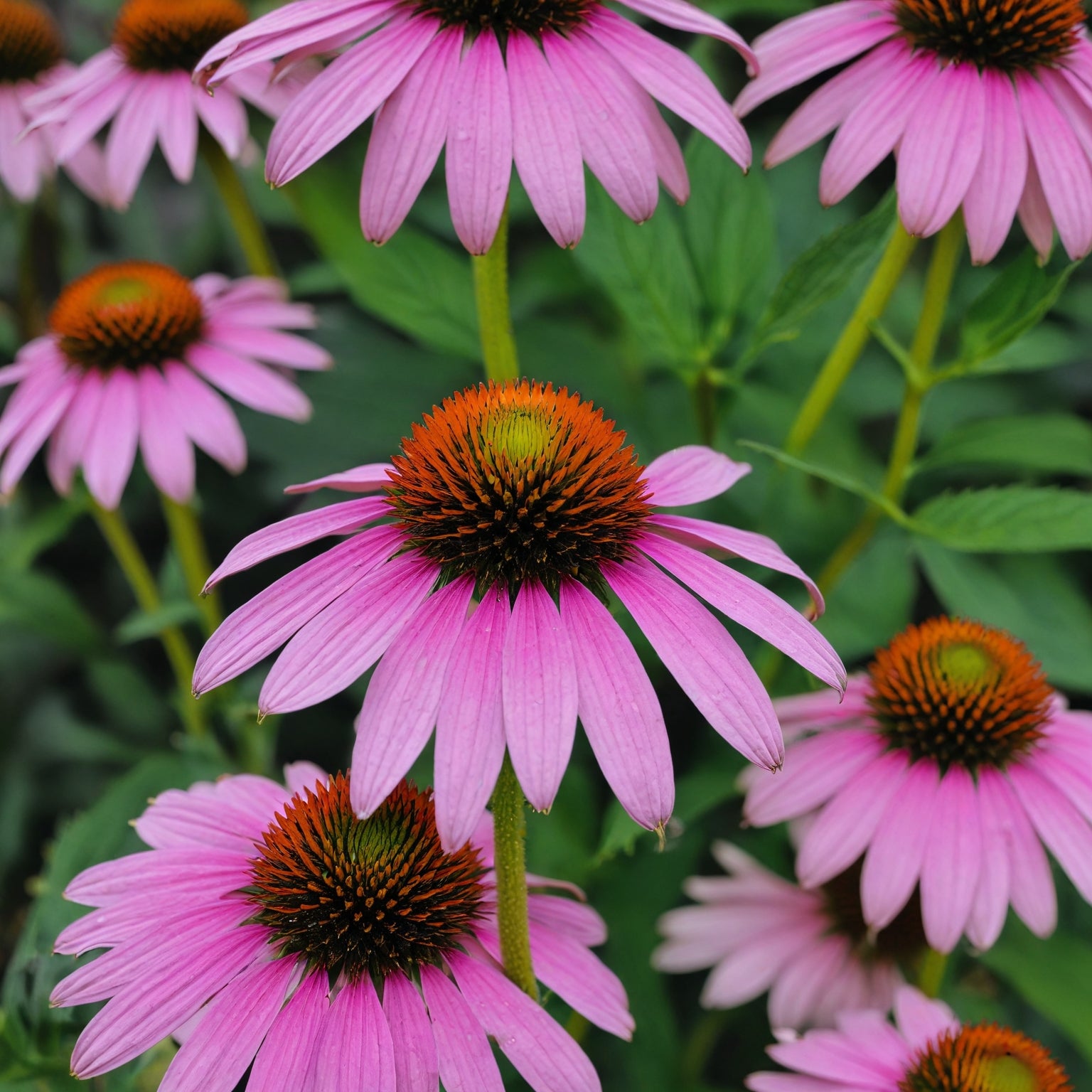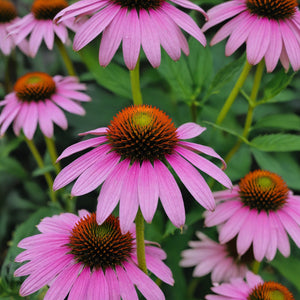- Hardiness Zone: 3-9 Perennial
Seed Depth: 1/4 inch
Seed Spacing: 12–18 inches
Row Spacing: 24–36 inches
Sunlight: Full sun to partial shade
Days to Sprout: 10–20 days
Days to Maturity: 120–150 days
Growth Habit: Upright, bushy perennial
Sunlight: Thrives in full sun but tolerates partial shade, especially in hotter climates.
Soil Type: Prefers well-drained soil with a pH of 6.0–7.0. Adding compost or organic matter enhances growth.
When to Plant: Sow seeds directly outdoors in spring after the last frost or in late fall for natural stratification over winter. Alternatively, start seeds indoors 6–8 weeks before the last frost.
Direct Sowing: Plant seeds 1/4 inch deep, spacing them 12–18 inches apart in rows 24–36 inches apart.
Indoor Sowing: Start seeds in trays, stratifying them in the refrigerator for 4–6 weeks before planting. Transplant when seedlings are 4–6 inches tall.
Succession Planting: Not typically needed; echinacea is a perennial that will return each year once established.
Watering: Water regularly during the first growing season to establish roots, then reduce watering as plants become drought-tolerant.
Fertilizing: Apply a light compost dressing at planting and mid-season to encourage healthy growth and blooms. Avoid over-fertilizing, as it can reduce flower production.
Pruning: Deadhead spent blooms to encourage reblooming. Cut back plants in late fall or early spring to prepare for the next season.
Pest and Disease Control: Generally pest-resistant, but monitor for aphids and fungal diseases. Use organic treatments if necessary.
When to Harvest: Harvest flowers when they are fully open for fresh or dried use. Roots can be harvested in the plant's second or third year for medicinal purposes.
How to Harvest: Use scissors or pruners to cut flowers at the base of the stem. For roots, carefully dig up plants after the growing season.
Seed Collection: Allow seed heads to dry on the plant. Collect seeds once the heads are completely dry and brittle.
Storing Seeds: Store seeds in an airtight container in a cool, dry place.
Why You’ll Love It
Echinacea, also known as Purple Coneflower, is a well-loved heirloom herb known for its immune-supporting properties and pollinator-friendly flowers. With large daisy-like blooms and strong stems, it adds color and structure to perennial borders, cottage gardens, and herbal beds. Echinacea thrives in full sun, tolerates drought once established, and returns year after year with minimal care. A must-have for gardeners who want beauty, resilience, and traditional herbal value in one plant.
Plant Characteristics
Height: 24–36 inches
Growth Habit: Upright and clump-forming with sturdy stems
Flower Type: Large purple-pink petals with prominent orange-brown cone centers
Days to Maturity: 100–120 days
Hardiness: Perennial in zones 3–9
Flavor and Culinary Uses
Flavor: Earthy and slightly floral with a hint of bitterness
Culinary Uses: Roots and flowers are traditionally used in herbal teas and tinctures for immune support. Not typically used in savory cooking.
Companion Planting Tips
Good Companions: Bee balm, black-eyed Susan, yarrow, and lavender
Avoid Planting Near: Heavy shade or poorly drained areas — echinacea thrives in dry, sunny spots
Bonus Benefit: Attracts bees, butterflies, and birds while offering long-lasting summer blooms and winter seed heads for wildlife
Common Issues and Solutions
Poor Flowering: Needs full sun and well-drained soil to thrive and bloom fully
Powdery Mildew: Space plants properly and avoid overhead watering to reduce humidity around foliage
Slow Start from Seed: Be patient — echinacea germinates slowly and often blooms in its second year
Seeds Per Packet
| 250mg | Approximately 222 |
| 500mg | Approximately 444 |
| 1g | Approximately 888 |
| 3g | Approximately 2,664 |
Why You’ll Love It
Echinacea, also known as Purple Coneflower, is a well-loved heirloom herb known for its immune-supporting properties and pollinator-friendly flowers. With large daisy-like blooms and strong stems, it adds color and structure to perennial borders, cottage gardens, and herbal beds. Echinacea thrives in full sun, tolerates drought once established, and returns year after year with minimal care. A must-have for gardeners who want beauty, resilience, and traditional herbal value in one plant.
Plant Characteristics
Height: 24–36 inches
Growth Habit: Upright and clump-forming with sturdy stems
Flower Type: Large purple-pink petals with prominent orange-brown cone centers
Days to Maturity: 100–120 days
Hardiness: Perennial in zones 3–9
Flavor and Culinary Uses
Flavor: Earthy and slightly floral with a hint of bitterness
Culinary Uses: Roots and flowers are traditionally used in herbal teas and tinctures for immune support. Not typically used in savory cooking.
Companion Planting Tips
Good Companions: Bee balm, black-eyed Susan, yarrow, and lavender
Avoid Planting Near: Heavy shade or poorly drained areas — echinacea thrives in dry, sunny spots
Bonus Benefit: Attracts bees, butterflies, and birds while offering long-lasting summer blooms and winter seed heads for wildlife
Common Issues and Solutions
Poor Flowering: Needs full sun and well-drained soil to thrive and bloom fully
Powdery Mildew: Space plants properly and avoid overhead watering to reduce humidity around foliage
Slow Start from Seed: Be patient — echinacea germinates slowly and often blooms in its second year
Seeds Per Packet
| 250mg | Approximately 222 |
| 500mg | Approximately 444 |
| 1g | Approximately 888 |
| 3g | Approximately 2,664 |







Share and get 15% off!
Simply share this product on one of the following social networks and you will unlock 15% off!